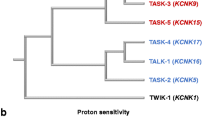Abstract
Elementary K+ currents through isolated ATP-sensitive K+ channels from neonatal rat cardiocytes were recorded to study their temperature dependence between 9°C and 39°C. Elementary current size and, thus, K+ permeation through the open pore varied monotonically with temperature with a Q10 of 1.25 corresponding to a low activation energy of 3.9 kcal/mol. Open-state kinetics showed a complicated temperature dependence with Q10 values of up to 2.94. Arrhenius anomalies of τopen(1) and τopen(2) indicate the occurrence of thermallyinduced perturbations with a dominating influence on channel portions that are involved in gating but are obviously ineffective in altering pore-forming segments. At 39°C, open-state exit reactions were associated with the highest activation energy (O2 exit reaction: 12.1 kcal/ mol) and the largest amount of entropy. A transition from 19°C to 9°C elucidated a paradoxical kinetic response, shortening of both O-states, irrespective of the absence or presence of cAMP-dependent phosphorylation. Another member of the K+ channel family and also a constituent of neonatal rat cardiocyte membranes, 66 pS outwardly-rectifying channels, was found to react predictably since τopen increased on cooling. Obviously, cardiac K +(ATP) channels do not share this exceptional kinetic responsiveness to a temperature transition from 19°C to 9°C with other K+ channels and have a unique sensitivity to thermally-induced perturbations.
Similar content being viewed by others
References
Anderson, C.R., Cull-Candy, S.G., Miledi, R. 1977. Potential-dependent transition temperature of ionic channels induced by glutamate in locust muscle. Nature 268:663–665
Ashford, M.L.J., Bond, C.T., Blair, T.A., Adelman, J.P. 1994. Cloning and functional expression of a rat heart KATP channel. Nature 370:456–459
Beam, K.G. 1981. Potassium currents in mammalian muscle. Biophys. J. 33:72a (Abstr.)
Beam, K.G., Donaldson, P.L. 1983. A quantitative study of potassium channel kinetics in rat skeletal muscle from 1 to 37°C. J. Gen. Physiol. 81:485–512
Benndorf, K., Koopmann, R. 1993. Thermodynamic entrophy of two conformational transitions of single Na+ channel molecules. Biophys. J. 65:1585–1589
Benz, I., Fröbe, V., Kohlhardt, M. 1991. Single cardiac outwardly rectifying K+ channels modulated by protein kinase A and a G-protein. Eur. Biophys. J. 20:281–286
Chapman, D. 1975. Phase transitions and fluidity characteristics of lipids and cell membranes. Quart. Rev. Biophys. 8:185–235
Colquhoun, D., Sigworth, F. 1983. Fitting and statistical analysis of single channel records. In: Single channel recordings. B. Sakmann and E. Neher, editors, pp. 191–264 Plenum, New York
Dreyer, F., Müller, K.D., Peper, K., Sterz, R. (1976). The M. omohyoideus of the mouse as a convenient mammalian muscle preparation. A study of junctional and extrajunctional acetylcholine receptors by noise analysis and cooperativity. Pfluegers Arch. 367:115–122
Fischbach, G.D., Lass, Y. 1978. A transition temperature for acetylcholine channel conductance in chick myoballs. J. Physiol. 280:527–536
Hamill, O.P., Marty, A., Neher, E., Sakmann, B., Sigworth, F.J. 1981. Improved patch-clamp techniques for high-resolution current recording from cell and cell-free membrane patches. Pfluegers Arch. 391:85–100
Ho, K., Nichols, C.G., Lederer, W.J., Lytton, J., Vassilev, P.M., Kanazirska, M.V., Hebert, S.C. 1993. Cloning and expression of an inwardly rectifying ATP-regulated potassium channel. Nature 362:31–37
Horn, R. 1991. Estimating the number of channels in patch recordings. Biophys. J. 60:433–439
Kirsch, G.E., Sykes, J.S. 1987. Temperature dependence of Na currents in rabbit and frog muscle membranes. J. Gen. Physiol. 89:239–251
Kohlhardt, M., Fichtner, H., Fröbe, U. 1989. Gating in iodate-modified single cardiac Na+ channels. J. Membrane Biol. 112:67–78
Kohlhardt, M. 1990. Different temperature sensitivity of cardiac Na+ channels in cell-attached and cell-free conditions. Am. J. Physiol. 259:C599-C604
Kumamoto, J., Rainson, J.K., Lyons, J.M. 1971. Temperature “breaks” in Arrhenius plots: a thermodynamic consequence of a phase change. J. Theor. Biol. 31:47–51
Lass, Y., Fischbach, G.D. 1976. A discontinuous relationship between the acetylcholine-activated channel conductance and temperature. Nature 263:150–151
Levy, H.M., Sharon, N.., Koshland, D.E. 1959. Purified muscle proteins and the walking rate of ants. Proc. Natl. Acad. Sci. USA 45:785–791.
McLarnon, J.G., Hamman, B.N., Tibbits, G.F. 1993. Temperature dependence of unitary properties of an ATP-dependent potassium channel in cardiac myocytes. Biophys. J. 65:2013–2020
Noma, A. 1983. ATP-regulated K+ channels in cardiac muscle. Nature 305:147–148
Noma, A., Takano, M. 1991. The ATP-sensitive K+ channel. Jap. J. Physiol. 41:177–187
Overath, P., Schairer, H., Stoffel, W. 1970. Correlation of in vivo and in vitro phase transitions of membrane lipids of Escheria coli. Proc. Natl. Acad. Sci. USA 67:606–612
Pahapill, P.A., Schlichter, L.C. 1990. Modulation of potassium channels in human T lymphocytes: effects of temperature. J. Physiol. 422:103–126
Parent, L., Coronado, R. 1989. Reconstitution of the ATP-sensitive potassium channel in skeletal muscle. J. Gen. Physiol. 94:445–463
Robinson, R.A., Stokes, R.H. 1955. Electrolyte solutions. Academic, New York
Romey, G., Chichreportchiche, R., Lazdunski, M. 1980. Transition temperatures of the electrical activity of ion channels in the nerve membrane. Biochim. Biophys. Acta. 602:610–620
Sandermann, H. (1978) Regulation of membrane enzymes by lipids. Biochim Biophys Acta 515:209–237
Schwarz, W. 1979. Temperature experiments on nerve and muscle membranes of frogs. Pfluegers Arch. 382:27–34
Author information
Authors and Affiliations
Rights and permissions
About this article
Cite this article
Haverkampf, K., Benz, I. & Kohlhardt, M. Thermodynamically specific gating kinetics of cardiac mammalian K +(ATP) channels in a physiological environment near 37°C. J. Membarin Biol. 146, 85–90 (1995). https://doi.org/10.1007/BF00232682
Revised:
Issue Date:
DOI: https://doi.org/10.1007/BF00232682




